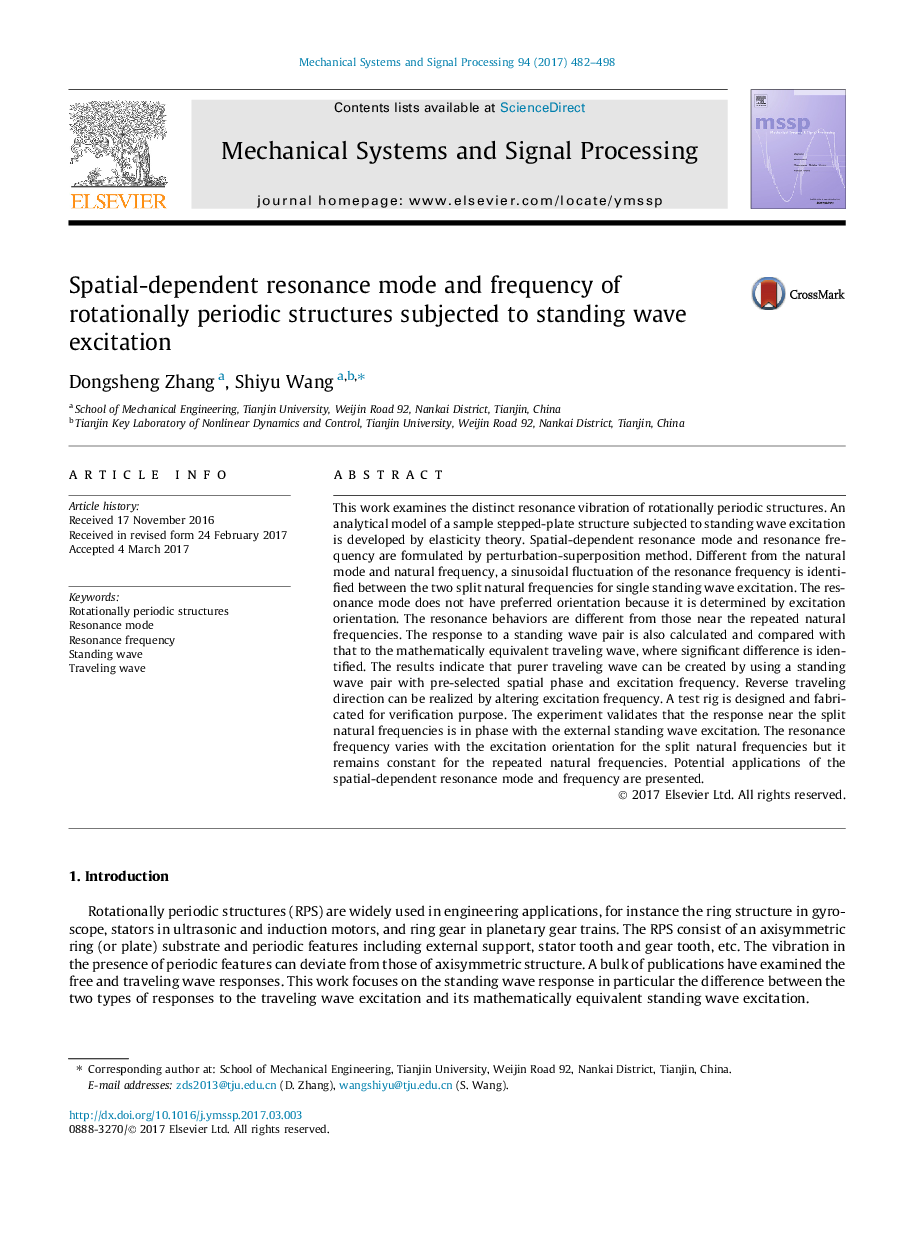| کد مقاله | کد نشریه | سال انتشار | مقاله انگلیسی | نسخه تمام متن |
|---|---|---|---|---|
| 4976953 | 1451841 | 2017 | 17 صفحه PDF | دانلود رایگان |
عنوان انگلیسی مقاله ISI
Spatial-dependent resonance mode and frequency of rotationally periodic structures subjected to standing wave excitation
ترجمه فارسی عنوان
حالت رزونانس وابسته به فضایی و فرکانس ساختارهای دوره ای متناوب تحت تحریک موج ایستاده
دانلود مقاله + سفارش ترجمه
دانلود مقاله ISI انگلیسی
رایگان برای ایرانیان
کلمات کلیدی
ساختارهای دوره ای متناوب چرخشی، حالت رزونانس، فرکانس رزونانس، موج ایستاده، موج حرکتی،
ترجمه چکیده
این کار ارتعاش رزونانس متمایز ساختارهای دوره ای چرخشی را بررسی می کند. یک مدل تحلیلی از ساختار پانل نمونه ای که تحت تحریک موج ایستاده قرار دارد، توسط تئوری کشش ایجاد شده است. حالت رزونانس وابسته به فضایی و فرکانس رزونانس با روش غلطکی-ابرنواختر فرموله شده است. متفاوت از حالت طبیعی و فرکانس طبیعی، نوسان سینوسی از فرکانس رزونانس بین دو فرکانس طبیعی تقسیم برای تحریک موج تک تک ایستاده است. حالت رزونانس گرایش ترجیح داده نمی شود، زیرا توسط جهت گیری تحریک تعیین می شود. رفتارهای رزونانس متفاوت از کسانی است که در نزدیکی فرکانس های طبیعی تکراری هستند. پاسخ به یک موج موج ایستاده نیز محاسبه شده و با آن مقایسه شده است تا موج حرکت ریاضی معکوس، که در آن تفاوت قابل توجهی مشخص شده است. نتایج نشان می دهد که موج حرکت خالص را می توان با استفاده از یک جفت موج ایستاده با فاز فضایی و فرکانس تحریک انتخابی انتخاب کرد. با تغییر فرکانس تحریک، می توان از جهت حرکت معکوس استفاده کرد. یک دستگاه تست برای اهداف تأیید طراحی و ساخته شده است. آزمایش معتبر است که پاسخ در نزدیکی فرکانس های تقسیم طبیعی در فاز با تحریک موج ایستاده خارجی است. فرکانس رزونانس با جهت گیری تحریک برای فرکانس های طبیعی تقسیم می شود، اما برای فرکانس های طبیعی تکرار می شود. برنامه های کاربردی پتانسیل حالت و فرکانس رزونانس وابسته به فضایی ارائه شده است.
موضوعات مرتبط
مهندسی و علوم پایه
مهندسی کامپیوتر
پردازش سیگنال
چکیده انگلیسی
This work examines the distinct resonance vibration of rotationally periodic structures. An analytical model of a sample stepped-plate structure subjected to standing wave excitation is developed by elasticity theory. Spatial-dependent resonance mode and resonance frequency are formulated by perturbation-superposition method. Different from the natural mode and natural frequency, a sinusoidal fluctuation of the resonance frequency is identified between the two split natural frequencies for single standing wave excitation. The resonance mode does not have preferred orientation because it is determined by excitation orientation. The resonance behaviors are different from those near the repeated natural frequencies. The response to a standing wave pair is also calculated and compared with that to the mathematically equivalent traveling wave, where significant difference is identified. The results indicate that purer traveling wave can be created by using a standing wave pair with pre-selected spatial phase and excitation frequency. Reverse traveling direction can be realized by altering excitation frequency. A test rig is designed and fabricated for verification purpose. The experiment validates that the response near the split natural frequencies is in phase with the external standing wave excitation. The resonance frequency varies with the excitation orientation for the split natural frequencies but it remains constant for the repeated natural frequencies. Potential applications of the spatial-dependent resonance mode and frequency are presented.
ناشر
Database: Elsevier - ScienceDirect (ساینس دایرکت)
Journal: Mechanical Systems and Signal Processing - Volume 94, 15 September 2017, Pages 482-498
Journal: Mechanical Systems and Signal Processing - Volume 94, 15 September 2017, Pages 482-498
نویسندگان
Dongsheng Zhang, Shiyu Wang,
